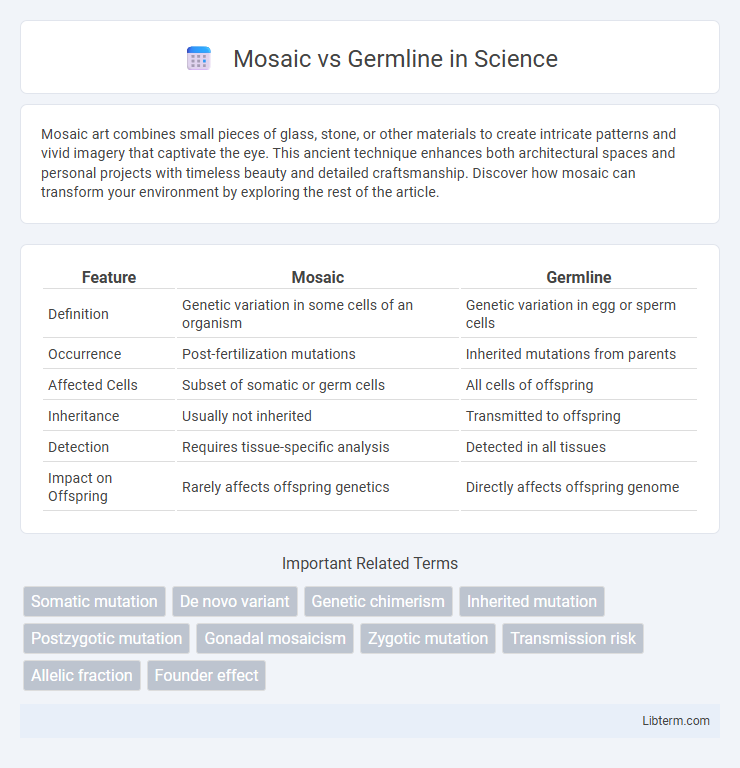Mosaic art combines small pieces of glass, stone, or other materials to create intricate patterns and vivid imagery that captivate the eye. This ancient technique enhances both architectural spaces and personal projects with timeless beauty and detailed craftsmanship. Discover how mosaic can transform your environment by exploring the rest of the article.
Table of Comparison
| Feature | Mosaic | Germline |
|---|---|---|
| Definition | Genetic variation in some cells of an organism | Genetic variation in egg or sperm cells |
| Occurrence | Post-fertilization mutations | Inherited mutations from parents |
| Affected Cells | Subset of somatic or germ cells | All cells of offspring |
| Inheritance | Usually not inherited | Transmitted to offspring |
| Detection | Requires tissue-specific analysis | Detected in all tissues |
| Impact on Offspring | Rarely affects offspring genetics | Directly affects offspring genome |
Understanding Mosaic vs Germline: Key Definitions
Mosaicism refers to the presence of two or more genetically distinct cell populations within one individual, originating from mutations after fertilization, affecting only certain tissues. Germline mutations occur in reproductive cells and are heritable, passed from parents to offspring, impacting every cell in the organism. Understanding the distinction between mosaic and germline mutations is essential for accurate genetic diagnosis and inheritance pattern predictions.
Genetic Origins: Mosaicism Explained
Mosaicism arises from genetic mutations occurring after fertilization, resulting in two or more genetically distinct cell populations within an individual, whereas germline mutations are inherited from a parent and present in every cell. Somatic mutations leading to mosaicism can happen during embryonic development or later in life, affecting only a subset of tissues. This genetic distinction impacts diagnosis, inheritance patterns, and phenotypic expression in mosaic versus germline mutation cases.
Germline Mutations: What Sets Them Apart
Germline mutations occur in the reproductive cells and are heritable, passing genetic changes to offspring, which distinguishes them from mosaic mutations that arise post-zygotically in somatic cells and are not inherited. These mutations affect every cell in the organism, leading to potential hereditary disorders or predispositions passed across generations. Detecting germline mutations is crucial for genetic counseling, disease risk assessment, and understanding inherited conditions like BRCA1-related cancers or cystic fibrosis.
Causes and Mechanisms of Mosaicism
Mosaicism arises from post-zygotic mutations occurring after fertilization, leading to genetically distinct cell populations within one individual, whereas germline mutations are inherited from parental gametes and present in every cell. Mechanisms driving mosaicism include errors in DNA replication, mitotic nondisjunction, and chromosomal rearrangements during early embryonic cell divisions, resulting in somatic or gonadal mosaic patterns. These mutational events create a spectrum of phenotypic variability, depending on the timing, location, and proportion of affected cells.
Germline Transmission: Inheritance Patterns
Germline transmission refers to the passage of genetic information from parent to offspring through reproductive cells, resulting in inheritance patterns that follow Mendelian genetics, including autosomal dominant, autosomal recessive, and X-linked traits. Unlike mosaic mutations that occur post-zygotically and affect only a subset of cells, germline mutations are present in every cell of the offspring, ensuring stable hereditary transmission across generations. Understanding germline inheritance is crucial for genetic counseling and predicting disease risk in descendants.
Detecting Mosaic and Germline Mutations
Detecting mosaic mutations involves analyzing multiple tissue samples or employing ultra-deep sequencing techniques to identify low-frequency variants present in a subset of cells, whereas germline mutations are typically detected through standard whole-exome or whole-genome sequencing of blood or saliva samples. Advanced bioinformatics tools and variant allele frequency thresholds are critical for distinguishing mosaic mutations from germline variants, as mosaic mutations often exhibit variant allele frequencies below 30%. Sensitive detection methods such as droplet digital PCR (ddPCR) and single-cell sequencing enhance the accuracy of identifying mosaicism, which has important implications for genetic counseling and disease prognosis.
Clinical Implications: Diagnosis and Treatment
Mosaic and germline mutations present distinct clinical implications for diagnosis and treatment, as germline mutations are inherited and present in every cell, allowing for early genetic testing and family risk assessment. Mosaic mutations, occurring post-zygotically, can lead to variable phenotypic expression depending on the proportion and distribution of mutated cells, complicating diagnostic accuracy and necessitating tissue-specific analysis. Personalized treatment strategies must consider mosaicism's potential for milder or atypical presentations, influencing therapeutic decisions and genetic counseling.
Research Advances in Mosaic vs Germline Studies
Recent research advances in mosaic versus germline studies have enhanced understanding of genetic mutations and their implications in developmental biology and disease mechanisms. High-resolution single-cell sequencing technologies enable detailed identification of mosaic variants within tissues, contrasting with germline mutations inherited and present in every cell. These innovations facilitate targeted therapeutic strategies and improved diagnostic accuracy for conditions influenced by mosaicism and germline alterations.
Ethical Considerations in Mosaic and Germline Genetics
Ethical considerations in mosaic and germline genetics center on the implications of genetic modifications passed to offspring versus those limited to an individual. Germline editing raises profound ethical concerns due to its heritable nature, potentially affecting future generations without their consent, while mosaic genetic interventions often involve somatic cells, posing fewer hereditary risks. Informed consent, equity in access, and the potential for unintended consequences remain critical challenges in both contexts.
Future Perspectives: Mosaic and Germline Breakthroughs
Future perspectives in mosaic and germline research focus on advancing gene-editing technologies like CRISPR to enable precise, safe therapeutic interventions. Innovations in single-cell sequencing and bioinformatics are enhancing detection and understanding of mosaic mutations, paving the way for personalized medicine. Emerging ethical frameworks and regulatory guidelines aim to balance the promise of germline modifications with societal concerns and long-term genetic impact.
Mosaic Infographic

 libterm.com
libterm.com